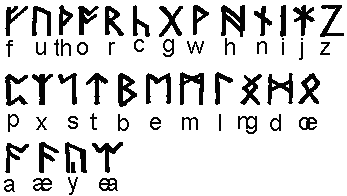Inefficiency in the Script
ᛁᛗᚪᚷᛁᚾᛖ ᚦᛖᚾ ᚪ ᚹᚩᚱᛚᛞ ᚹᚻᛖᚱᛖ ᛖᛝᛚᛁᛋᚻ ᚹᚪᛋ ᚹᚱᛁᛏᛏᛖᚾ ᚹᛁᚦ ᚱᚢᚾᛖᛋ
Imagine then a world where english was written with runes
Instead the English Language is written using the Latin Script.
There is a non-zero implementation shortfall in the orthography of English using the latin script vs how it is pronounced. This pronunciation differential arises from the implementation of the script for use with a Germanic language like Anglo Saxon during the 5th-9th Century, and the initial use case of the script in pronouncing Latin phenoms across the Roman Empire. Early versions of Old English were written using Anglo-Saxon Runes also known as “Futhorc”.
Being that Anglo-Saxon Old English is a derivative of North Sea Germanic languages and an older version of Futhorc runes was the standard writing system for other Germanic languages at the time, this system of writing was nearly tailor made for use with Old English.
See: The Path of the Alphabet and English Language Timelines
Return to Futhorc
The usage of Runes with Modern English could overcome a large part of the shortfall that the Latin Alphabet has in pronunciation even today.
Modern English carries forward multiple sounds from its old German roots that were simply not present in Roman version of Latin. Namely “th”, “w”, “ng”, and “k”.
As a consequence of adopting Latin script into Old English, early writers had to get creative with their use of the script to accommodate.
“th” and “ng” - were not present in Latin and could only be used by combining and modifying the phonetics of two letters. This was common in other areas of latin such as “ch” or “ph”.
“W” - or literally ” Double U” - had no native pronunciation in latin so it had to be codified into the script using two “u” symbols.
“k, c, q” - All have the same base sound in English but require a slightly higher mental load to choose the right version per selected word.
Instead imagine the following simplification of sounds:
ᚦ (thorn) = “th” as in “thing” ᚹ (wynn) = “w” as in “window” ᛝ (Ing) = “ng” ᚳ (ce) = “k, C, Q as in Queen”

Using the key above, read this sentence. (words are separated with a ”.” or “x”)
ᚦᛁᛋ × ᛋᛁᛋᛏᛖᛗ × ᚩᚠ × ᚹᚱᛁᛏᛁᛝ × ᛁᛋ × ᛗᚢᚳᚻ × ᛋᛁᛗᛈᛚᛖᚱ × ᚹᛁᚦᚩᚢᛏ × ᚦᛖ × ᚢᛋᛖ × ᚩᚠ ᛚᚪᛏᛁᚾ × ᛋᚳᚱᛁᛈᛏ × ᛁᛗᚪᚷᛁᚾᛖ × ᚦᛖ ᚩᛈᛏᛁᛗᛁᛋᚪᛏᛡᚾᛋ × ᚢᛋᛁᛝ × ᚠᚢᚦᚪᚱᚳ × ᚹᚩᚢᛚᛞ × ᛒᚱᛁᛝ